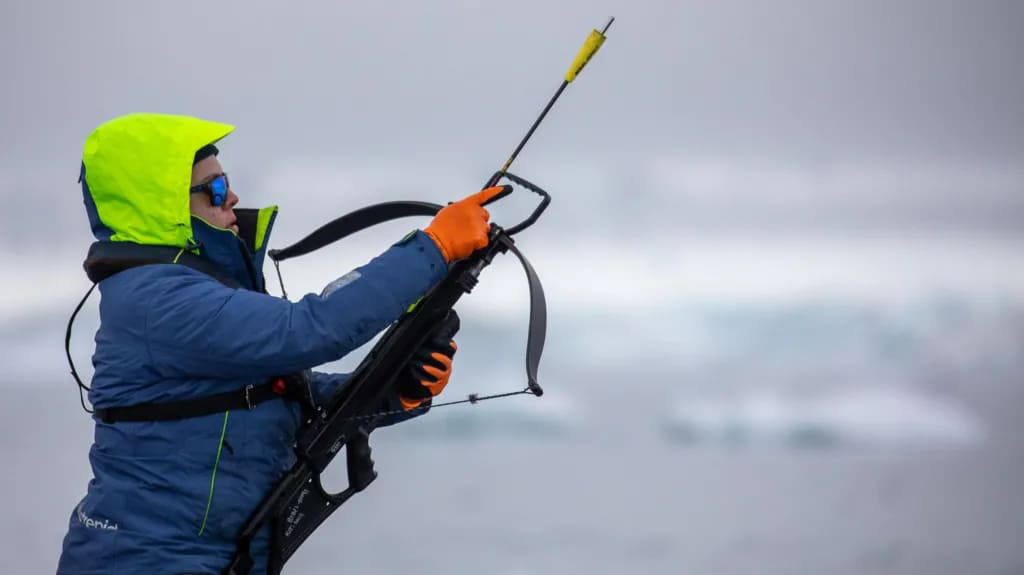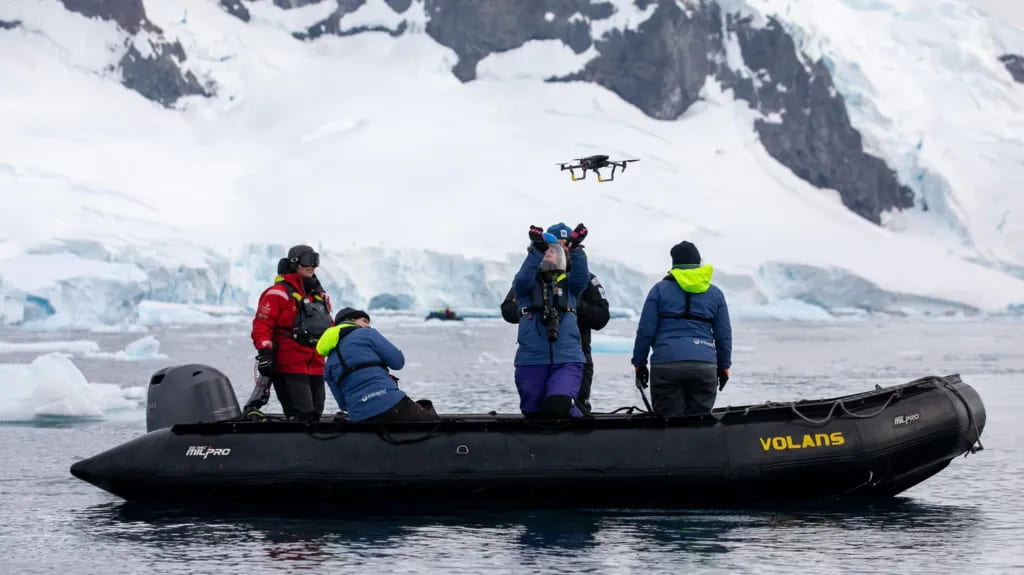Inside the bodies of humpback whales lie clues about the transformative effects of climate change on Antarctica. The BBC science team embarked on a mission across the Southern Ocean with researchers to follow and study these majestic giants in their remote, frozen habitat.
At 3:00 AM, a massive crash jolts us awake as every drawer in the cabin flings open, spilling contents against the walls. We've encountered a 12-meter wave. Though alarming to me, a non-seafarer, such turbulence is typical in the Drake Passage, the notoriously rough stretch of the Southern Ocean we're traversing. We're aboard a 200-passenger tourist ship, accompanied by a team of wildlife scientists, en route to the Antarctic Peninsula.
Among the researchers is Dr. Natalia Botero-Acosta, who carries a unique piece of equipment: a custom-made crossbow. "It's not a weapon," she clarifies, "but a scientific tool for collecting whale skin and blubber samples." With this crossbow and a drone, the researchers aim to conduct health checks on every humpback whale they encounter, assessing whether these massive mammals are getting enough to eat.
This question is crucial not only for the 40-tonne humpbacks that travel vast distances to feast in these cold waters but also for the health of the ocean and the planet. In the rich, frigid seas off the peninsula, penguins, seals, and various whales thrive on Antarctic krill, tiny shrimp-like creatures that flourish under sea ice. As the climate warms, scientists are racing to understand the implications for this ice-dependent food source.
On the first calm Antarctic morning, we set out on a small inflatable boat called a zodiac. As clouds descend and snow begins to fall, Chris Johnson, the wildlife charity WWF's global whale conservation expert, leads the mission. "In conditions like this," Chris says, "the best way to find whales is by listening - we’ll switch off the zodiac engine and close our eyes."
The resulting silence is profound. The overlapping sounds of whale exhalations echo off mountains rising from the glassy water. Gigantic, hungry humpbacks feed around us, diving and opening their mouths to let krill-laden seawater rush in. We slowly approach the nearest blows, and Natalia readies her crossbow.
Whale blubber contains chemical clues about their environment, which Natalia plans to collect. She picks up a crossbow bolt with a 3cm metal tip designed to pluck a piece of skin and blubber from the whale. A rubber stopper ensures it only takes a small sample before bouncing off and floating. "It's like a mosquito bite," says Natalia. When her bolt nicks a huge female whale, the animal doesn't flinch.

This mother whale, accompanied by her calf, circles the boat curiously before gliding underneath us. "Hold on in case she comes up," Chris warns, but she surfaces on the other side with a blow. The calf is even more inquisitive, raising its head out of the water to inspect us. I can’t help but greet it: "Hello, beautiful."
Baby humpbacks spend a year nursing on their mothers' rich milk, making calories crucial. "We need to identify critical feeding habitats for whales to protect them," Chris explains. Whale health reflects the entire Antarctic ecosystem's health, and whales play a vital role: they eat krill, which consume ice-dependent microscopic plants that absorb carbon. Whale feces fertilize these plants, sustaining a productive cycle disrupted by climate change.
In this bay, Natalia sets up another biopsy, synchronized with the whale's movements. When the whale arches its back, Natalia's bolt captures a tissue sample. Back at her lab, Natalia can determine if the whale was hungry, stressed, or pregnant from the chemical signals in its blubber. "Pregnancy data is invaluable," she says, noting that low sea ice correlates with lower pregnancy rates, highlighting climate change's impact.
Most mature humpbacks here consume about three million Antarctic krill daily, preparing for their 8,000km migration to tropical breeding grounds. Though tiny, collectively krill weigh about 400 million tonnes, similar to the combined human weight. Krill depend on sea ice, grazing on its algae and sheltering in its crevices. Marine ecologist Prof. Angus Atkinson warns that climate change threatens krill. Since 2017, Antarctic sea ice has seen a worrying decline, reaching record lows in 2023.
The team also studies whales using a drone, capturing behavior not visible from the surface. Chris launches his drone, observing humpbacks performing bubble net feeding. The drone helps weigh whales by measuring their body dimensions, revealing evidence of climate-linked food shortages. A study of Southern right whales showed they are 20% thinner than 30 years ago. Monitoring humpback weight provides more clues about krill populations and whale health.
Krill biologist Prof. So Kawaguchi emphasizes understanding krill's life cycle and behavior, as climate change could push them out of predators' reach. Chris notes that whale health reflects various threats, including climate change, fisheries, ship strikes, and noise pollution.

There is a krill fishery in the Southern Ocean, with oil used in animal feeds and supplements. The WWF advocates for no-fishing zones in critical wildlife feeding habitats. As Chris watches his drone, he exclaims, "Mom’s pooping!" Sarah Kienle collects the floating feces, calling it "liquid, smelly gold" for its rich information.
Back on the ship, samples are stored in a freezer for transport to Natalia’s lab. Despite the challenges of working from a tourist ship, it allows the team to access multiple sites around the peninsula. Tourism has increased dramatically, with a record 104,000 visitors in the 2022-2023 season. This rise brings environmental concerns, but witnessing Antarctica firsthand can inspire advocacy for its protection.
On the last day, two whales we’re tracking stop next to an iceberg and fall asleep. Natalia gently splashes water to wake them, finally collecting one last precious sample. Monitoring this environment is crucial for humanity, as this productive, icy ocean helps cool the planet. The scientists hope to return next summer to continue their vital work.
